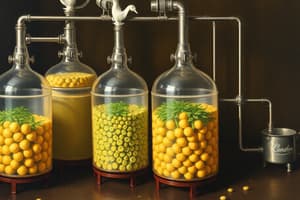Podcast
Questions and Answers
What is the primary product of alcohol fermentation?
What is the primary product of alcohol fermentation?
- Carbon dioxide
- Glucose
- Ethanol (correct)
- Lactic acid
What is one key advantage of using immobilized cells over immobilized enzymes?
What is one key advantage of using immobilized cells over immobilized enzymes?
- They save time in isolating and purifying enzymes. (correct)
- They increase product yield.
- They can only be used in fermentation.
- They are easier to purify.
What temperature is typically used for incubating milk when making yogurt?
What temperature is typically used for incubating milk when making yogurt?
- 50 degrees Celsius
- 60 degrees Celsius
- 40 degrees Celsius (correct)
- 30 degrees Celsius
Which biochemical process follows glycolysis in lactic acid fermentation?
Which biochemical process follows glycolysis in lactic acid fermentation?
What substance is used to immobilize yeast cells in fermentation?
What substance is used to immobilize yeast cells in fermentation?
Flashcards
Biotechnology
Biotechnology
The use of living organisms or their products in industrial processes to create useful products.
Bioprocessing
Bioprocessing
A process that uses enzymes controlled reactions to produce a product. Basically, it's the use of biological catalysts.
Bioreactor
Bioreactor
A closed system where living organisms or their products are used to manufacture valuable substances. Think of it as a controlled environment for biological reactions.
Immobilized cells
Immobilized cells
Signup and view all the flashcards
Alcohol Fermentation
Alcohol Fermentation
Signup and view all the flashcards
Study Notes
Industrial Fermentation
- Biotechnology is the use of living cells/enzymes to make useful products or carry out reactions
- Bioprocessing is the use of enzyme-controlled reactions to produce a product
- A bioreactor is a vessel in which a product is made by living cells
- Immobilised cells are cells attached to each other or an inert material, making them more effective than immobilised enzymes which often have a high cost for isolation and purification
Alcohol Fermentation (Brewing)
- Glycolysis is followed by the conversion of pyruvic acid to ethanol and carbon dioxide in alcohol fermentation
- Yeast cells can be immobilised in sodium alginate beads and placed in a sugar solution (e.g., glucose) in a large bioreactor
- Yeast respires anaerobically to produce ethanol and carbon dioxide as waste products
- Yeast is used in baking to raise dough due to carbon dioxide production
Lactic Acid Fermentation
- Glycolysis is followed by the conversion of pyruvic acid to lactic acid in lactic acid fermentation
- Pasteurised milk is inoculated with yogurt bacteria and incubated at 40°C for 6 hours
- The lactic acid produced from anaerobic respiration of bacteria curdles the milk and turns it into yogurt
Studying That Suits You
Use AI to generate personalized quizzes and flashcards to suit your learning preferences.




